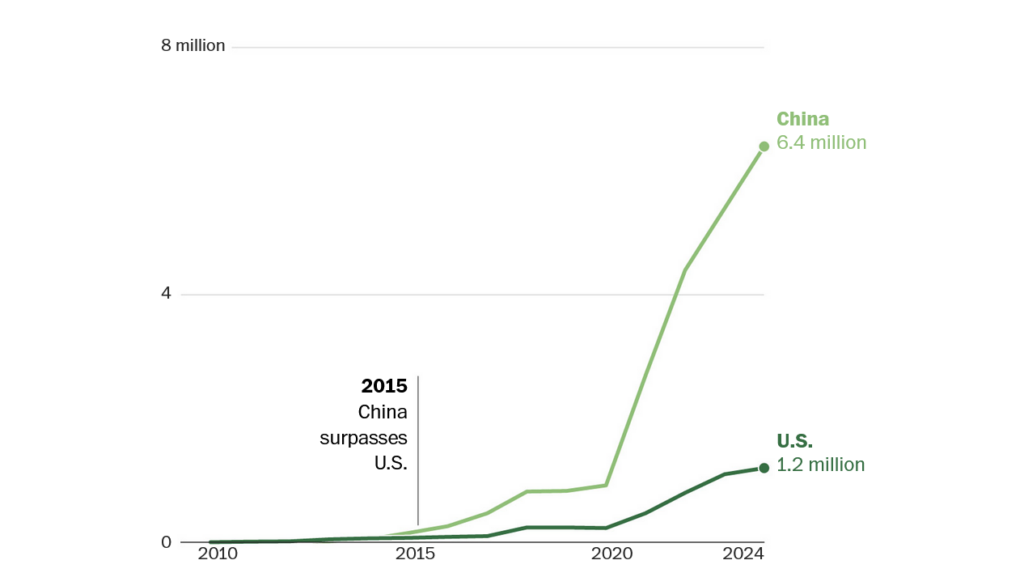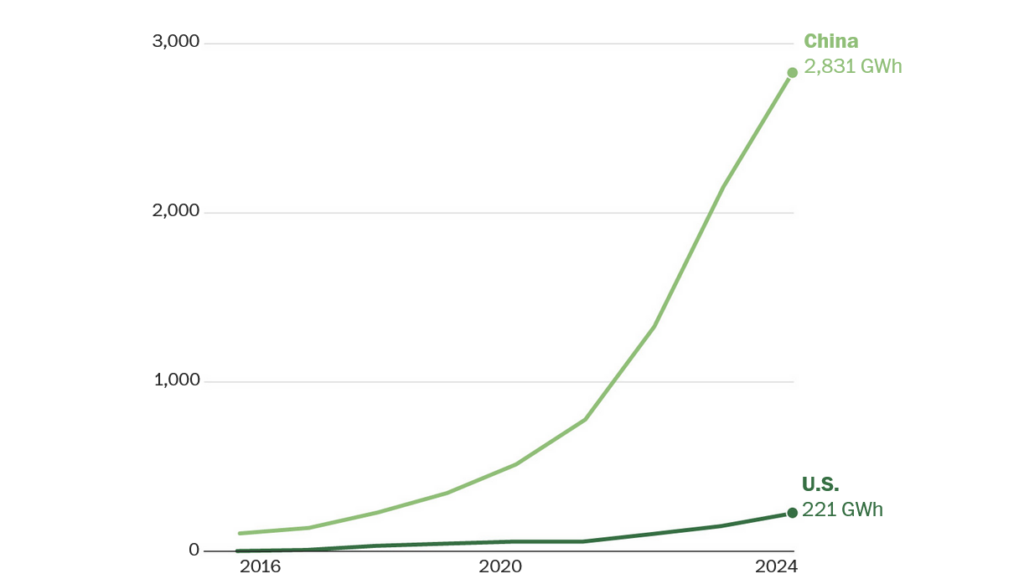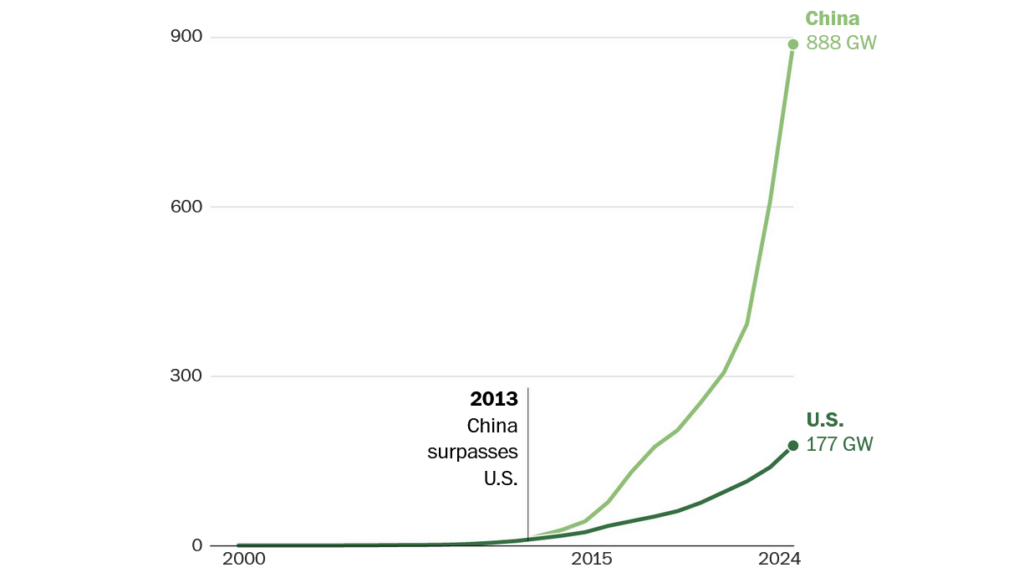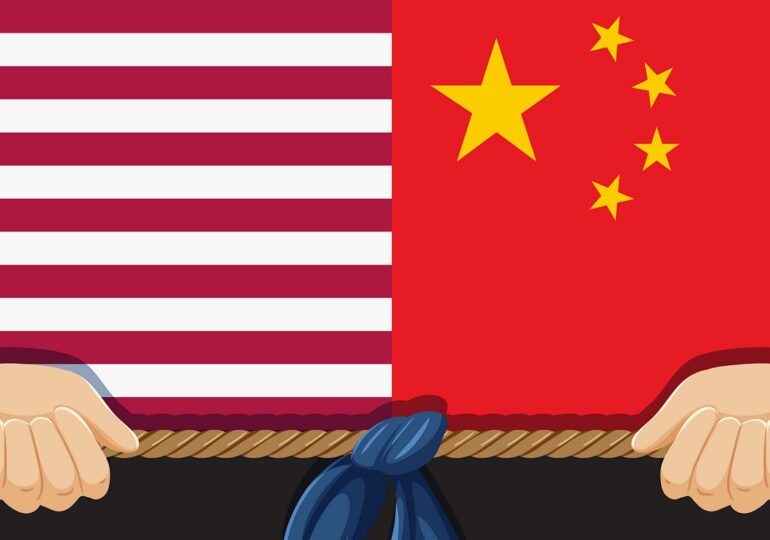China dominates the global market for green technologies such as electric vehicles, batteries, and solar panels. And these technologies have something in common: they were all invented in the United States.
Since the early 2000s, various incentives and government policies have brought China to the forefront of the electric vehicle, solar panel, and battery market. In an alternative reality, the US could have become the global leader.
The Washington Post explains why Americans lost the initial advantage of innovation and how China surged ahead.
Electric Vehicles
Electric Vehicle Sales

Once, it seemed like American roads would be filled with electric vehicles. Inventor William Morrison developed the first successful electric car in 1890, and interested city dwellers soon began converting their garages into charging stations.
By the early 1900s, about one-third of all vehicles on American roads were electric. In New York, a taxi company named the Electric Vehicle Company operated electric vehicles with interchangeable batteries, an early form of Uber or Lyft.
But at that time, many rural areas still lacked reliable electricity: widespread electrification only began in the '30s. Meanwhile, oil companies had already established a gasoline distribution network across the country. "Much of rural America was still using gasoline for stoves and kerosene for lighting homes. You could buy gasoline at a lot of stores across the country," said David Kirsch, a professor of management and entrepreneurship at the University of Maryland.
This made gasoline engines more convenient for consumers. Meanwhile, internal combustion engines improved much faster than battery technology. Ford's assembly line allowed new gasoline cars, like the Model T, to be produced more quickly. By the '30s, there were only a small number of electric vehicles on the roads.
Over 50 years later, the country had another chance. California announced it would require automakers to sell a certain amount of electric vehicles. General Motors built the EV1, a small two-seater sedan that quickly became popular in the state. But in the mid-'90s, when California regulators abandoned this plan, GM quietly reclaimed the produced vehicles and scrapped them. The US would continue to focus on fossil fuel cars.
This American focus initially motivated China to transition to electric vehicles over a decade ago. Around 2010, China's Minister of Science and Technology, Wan Gang, began pushing the country to expand into electric cars. American companies already dominated the internal combustion engine market, and China was looking for technologies its companies could dominate in the coming decades.
From 2010 to 2023, China rolled out a slew of subsidies to encourage electric vehicle adoption. Interested buyers could get up to a 60,000 yuan discount on an electric vehicle, roughly $8,000 - a huge benefit in a country where a new car averages $23,000.
Electric vehicle owners were also exempt from sales tax and received a special colored license plate (green instead of blue), allowing them to skip years-long registration wait times. Manufacturers also received incentives, including tax exemptions and quicker approvals and placements for factories producing electric vehicles and batteries.
According to an estimate by the Center for Strategic and International Studies, the Chinese government invested around $231 billion in electric vehicle adoption - and this is likely an underestimate.
The investments paid off. In 2010, both China and the US were selling just over 1,000 electric vehicles per year. Last year, the US sold 1.2 million - while China sold 6.4 million. And as the US Congress reduces incentives for electric vehicles, the gap is likely to widen. "There's a real danger that the US could become more technologically isolated in the auto sector," said Ilaria Mazzocco, deputy director and senior researcher in Chinese business and economics at the Center for Strategic and International Studies.
Lithium-Ion Batteries
Lithium-Ion Battery Production Capacity in Gigawatt-Hours

Batteries followed a similar trajectory to electric vehicles.
In the early '70s, M. Stanley Whittingham, then a scientist at Exxon, created the first functional lithium-ion battery - a design later improved by John Goodenough at the University of Oxford and Japanese scientist Akira Yoshino from Asahi Kasei Corp.
Initially, the new technology became popular in the '90s in the electronics field, such as early laptops and mobile phones, as Li-ion batteries were compact and reliable.
But in the early 2000s, batteries began to make their way into a new generation of electric cars. An American company named A123 was one of the first producers of lithium-iron phosphate batteries with enough capacity to power a car. In 2009, the Department of Energy granted the company hundreds of millions of dollars in subsidies under the American Recovery and Reinvestment Act.
However, the US did not stimulate electric vehicle sales, and the first battery manufacturers struggled to find a foothold in a market dominated by gasoline cars and trucks. A123 went bankrupt and was later bought by a Chinese company.
In the early 2010s, as its electric vehicle sales surged, China invested billions of dollars in battery technology and manufacturing.
At the same time, it invested in processing critical minerals like cobalt, nickel, and graphite - adding stability to the complex battery supply chain.
In 2021, the technology received another boost: Beijing began requiring companies to add 10 to 30% battery storage for every gigawatt of wind or solar energy brought online.
Battery production skyrocketed. "It just exploded," said Iola Hughes, head of research at Rho Motion, a battery research firm and part of Benchmark Mineral Intelligence consultancy.
Today, China boasts 85% of global battery cell production capacity. In the case of electric vehicle batteries, the situation is even more stark: China holds a 94% market share for producing lithium iron phosphate batteries.
Solar Panels
Solar Energy Capacity in Gigawatts

For decades, solar panels were an American creation. In 1954, scientists at Bell Labs created the world's first commercially viable solar cell, converting 6% of received light into electricity.
By the '70s, solar energy was booming in the US. The country was in the midst of an oil crisis, and the federal government directed millions of dollars towards solar energy research and development. Scientists and engineers from around the world came to the US to develop solar technologies.
President Jimmy Carter installed 32 panels on the White House roof. According to an estimate, 95% of the global solar industry was concentrated in the United States in 1978.
But in the '80s, everything changed. President Ronald Reagan drastically cut funding for renewable energies and research and development in solar energy. "It was a truly ideological situation. They cut the budget for solar energy by 85% in just a few years," said Greg Nemet, professor of public affairs at the University of Wisconsin.
Germany and Japan filled the void left by the American administration, attracting experienced engineers and scientists.
Then, in the early 2000s, European countries began offering huge subsidies for the installation of wind and solar systems. Chinese companies sensed an opportunity and started building millions of panels.
"There was an increasing demand in the early and mid-2000s, thanks to all these incentives from Europe, and many entrepreneurs in China set up factories to meet this demand," said Mazzocco.
After the financial crisis of 2008, Europe phased out these subsidies as the continent turned towards austerity. But, unlike the approach taken by the US decades earlier, Beijing decided to continue supporting the development of solar energy. "The Chinese government intervened," said Mazzocco.
So far, China has invested $50 billion in new solar energy production, and the country now represents approximately 80% of the global solar supply chain. Today, eight out of the top 10 solar panel manufacturers are based in China. The other two are in India and Singapore.
Experts say the country's success is based on two things: a reliable policy and a drive to adopt new technologies. "I look at the period from '69 to the present - what strikes me is how inconsistent we have been in terms of policy. The Chinese have cleaned our clock by having consistent policy," said Kirsch.
At the same time, Beijing has pushed consumers to adopt the technologies, not just encouraged producers to build them. "Technologies succeed when you combine a technological opportunity with a market opportunity," said Nemet.
"The US has done very well at creating these technological opportunities - but, simply put, we haven't supported the market side enough," he said.
T.D.

